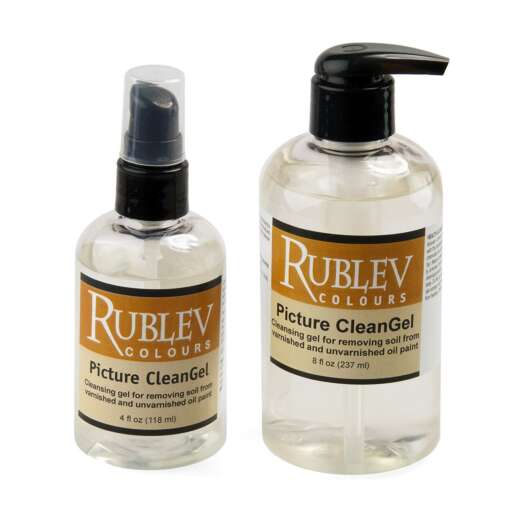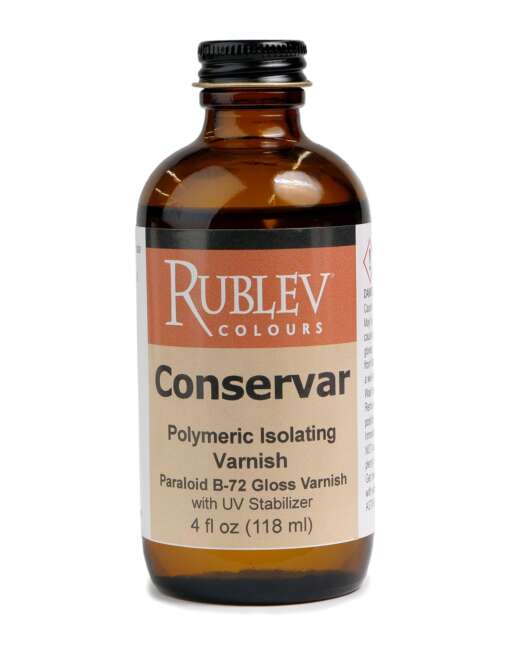Conservators use specific cleaning agents based on the painting’s condition. Common cleaning agents include organic solvents, enzyme-based cleaners, and neutral pH solutions. Solvents such as mineral spirits (white spirits) may be used to remove dirt or discolored varnish, while enzyme-based cleaners can target organic residues. Every cleaning method is carefully tested on a small area to ensure it does not damage the paint. For more information on cleaning oil paintings, please see Best Practices for Cleaning Paintings.
Painting Conservation: Best Techniques and Materials for Artists

Understanding the characteristics of artists’ materials is crucial for ensuring the longevity and integrity of artworks. Recent interdisciplinary studies reveal how materials like oil paints, canvas, and varnishes behave under different conditions. The following insights focus on improving preservation methods and choosing the right materials for paintings on various supports.
Understanding Paint Behavior: Shrinkage, Cracking, and Degradation
Oil paints undergo chemical changes as they dry and age, affecting their flexibility and cracking vulnerability. Janas et al.’s study on oil paint shrinkage explains that drying oils experience oxidation and crosslinking, causing the paint film to become stiffer over time. This stiffening, coupled with molecular relocation and the evaporation of volatile components, can lead to shrinkage that exceeds the paint’s capacity to stretch, resulting in cracks. The risk of brittleness and cracking increases as the paint film ages, especially when applied to stable substrates that do not expand or contract to accommodate the paint layer’s changes.
While more flexible binders can reduce brittleness, artists choose the painting medium based on aesthetic qualities over flexibility. Consequently, relying on flexibility alone is not always feasible. Instead, the studies reviewed here emphasize other practical strategies that align with artists’ materials and techniques:
Choose Rigid Supports: While flexible supports like stretched canvas may allow some movement, they can induce stress on the paint layer over time, especially in fluctuating humidity. Using rigid supports like wood panels or metal can provide greater dimensional stability. These supports minimize the movement of the paint film, reducing the likelihood of cracking.
Manage Environmental Conditions: Stable humidity and temperature are crucial in preserving oil paintings. By controlling relative humidity within a narrow range (40-60%), artists can limit the stress on both the paint film and its support. Backing boards and UV-filtered glazing can further protect paintings from environmental variations.
Select Pigments Carefully: Pigments significantly impact the behavior of oil paint films. For instance, lead white forms tougher films that resist cracking better than zinc white, which tends to produce more brittle layers. When possible, opting for pigments with more stable film properties can enhance the overall durability of the artwork.
Lightfastness of Important Historical Pigments
| Permanent | Durable | Intermediate | Fugitive | ||||||
| ISO Rating | 8 | 7 | 6 | 5 | 4 | 3 | 2 | 1 | |
| Carbon black | Cadmium | Alizarin (Madded Lake) | Carmine lake | ||||||
| Ochre, umber, Sienna | Ultramarine blue | Full | Half | Tint | Gamboge*** | ||||
| Iron oxide | Vermilion | Quercitron lake*** | |||||||
| Green earth (terre verde) | Carmine | ||||||||
| Azurite | Full | Tint | |||||||
| CS 98-62 Class I** | |||||||||
| ASTM D4303 Lightfastness Category I** | |||||||||
Years+ to First Perceptible Color Change++ | |||||||||
| 30 | 10 | 3 | 1 | at 10,000 lux | |||||
| 100 | 100 | 30 | 10 | 3 | 1 | at 1,000 lux | |||
| 1,000 | 300 | 100 | 30 | 10 | 3 | 1 | at 300 lux | ||
| 6,000 | 2,000 | 600 | 200 | 60 | 20 | 6 | 2 | at 50 lux | |
* Cadmiums (red, yellow) may, in fact, be permanent, but the data so far places them at the high end of durable.
** These U.S. artists’ paint standards include both permanent and durable colors in their top category. The Commercial Standard for Artists Oil Paints CS 98-62 was issued by the U.S. Department of Commerce. First printed in 1942, the Paint Standard provides specifications for the minimum quality required of artists’ colors.
*** These yellows were also part of many greens, such as Hooker’s green, sap green, and Prussian green.
+ 3000 hours per year, i.e., 300 days x 10 hours.
++ Almost complete loss of the color takes about 30 times longer, less for tints.
Light damage to some important historical pigments. This chart assumes good UV filtration and ignores other effects on permanence, such as pollution. Adapted from the article Time’s Effects on Paintings by Stefan Michalski.
Balancing Environmental Conditions: Humidity and Light
Michalski’s work emphasizes that environmental factors, such as relative humidity (RH) and light exposure, are critical agents of painting deterioration. To limit stress-induced cracking, his research advises maintaining RH at 40-60%, with fluctuations kept within ±10%. He also recommends displaying paintings under low-intensity light (50-150 lux) to prevent fading, especially of fugitive pigments, while allowing safe public visibility.
For optimal preservation, galleries should use UV filters and backing boards to maintain stable RH levels. These preventive measures are essential for maintaining the mechanical and visual integrity of paintings and reducing the risks of cupping, flaking, or discoloration.

Nude (Après le bain) (1903) Pierre Bonnard (French, 1867-1947), oil on cardboard.
Case Study: Pierre Bonnard’s Use of Cardboard Supports
Victoria Skalleberg’s technical study of Pierre Bonnard’s painting Nude (Après le bain) provides insights into the challenges of using cardboard as a support for oil paintings. Cardboard, being acidic and prone to absorbing oils, often leads to issues like staining, delamination, and pigment loss. This study identifies the specific materials in Bonnard’s work, including pigments like zinc white and vermilion, and concludes that using a dammar varnish exacerbated yellowing over time.
Artists considering non-traditional supports, such as cardboard, should be aware of these potential issues and may choose to apply barrier layers to prevent direct contact between the oil paint and the support, thus reducing acidity-related deterioration. Conservation strategies should include pH-neutral backings and storage in climate-controlled conditions to slow down degradation.
Protective Coatings for Fabrics and Painted Canvases
Giulia Mazzon’s research into fabric conservation also provides valuable insights for artists working on fabric supports. Her study on protective treatments indicates that polyurethane-modified emulsions can offer hydrophobic yet breathable protection for canvas. These coatings enhance the material’s resistance to humidity, pollutants, and oxidative damage, making them suitable for extending the lifespan of painted canvases. However, artists should ensure that such treatments do not alter the paint’s appearance or flexibility.
Prioritizing Conservation-Friendly Materials and Techniques
Recent research underscores the importance of selecting the right materials and maintaining controlled environments to preserve paintings effectively. Artists should be proactive in understanding the behavior of their chosen materials and consider how changes over time can impact their work’s stability and aesthetics. Implementing these recommendations not only preserves the physical integrity of artworks but also supports their visual and historical value.
Bibliography
Janas, Arkadiusz, Marion F. Mecklenburg, Laura Fuster-López, Roman Kozłowski, Patrick Kékicheff, Damien Favier, Cecil Krarup Andersen, Mikkel Scharff, and Łukasz Bratasz. “Shrinkage and Mechanical Properties of Drying Oil Paints.” Heritage Science 10, no. 181 (2022): 1-20. https://doi.org/10.1186/s40494-022-00814-2. Read the full article here.
Summary: This article explores the mechanical behavior and shrinkage of drying oil paints, focusing on how their molecular composition changes during the drying and aging process. The study reveals that paint layers become stiffer and more brittle over time, which can lead to cracking if the underlying support does not accommodate the paint’s dimensional changes. The authors also examine the impact of different pigments on the flexibility and durability of oil paint films, offering crucial insights for artists and conservators aiming to preserve artworks in the long term.
Michalski, Stefan. Time’s Effects on Paintings. Canada: Canadian Conservation Institute. Read the full article here.
Summary: Michalski’s work outlines the environmental factors that contribute to the deterioration of paintings, emphasizing the roles of light, relative humidity, temperature, and pollution. He offers preventive conservation strategies, such as limiting light exposure to 50-150 lux, maintaining stable relative humidity (40-60%), and using UV filters. These recommendations are grounded in scientific analysis and aim to extend the physical and visual integrity of paintings across generations.
Skalleberg, Victoria. “Nude (Après le Bain): An Interdisciplinary Technical Study of an Oil Painting on Cardboard by Pierre Bonnard.” Master’s thesis, University of Gothenburg, 2020. Read the full article here.
Summary: This thesis examines Pierre Bonnard’s painting techniques, particularly his use of cardboard as a support for oil painting. The study identifies the materials used, including zinc white, cadmium yellow, and dammar varnish, while also assessing the conservation challenges posed by the acidic nature of cardboard and the interaction of oil with the support. Skalleberg’s analysis provides recommendations for the conservation of similar works, emphasizing the need for pH-neutral backing and protective coatings.
Mazzon, Giulia. “Protective Treatments in Fabrics Conservation.” PhD diss., Università degli Studi di Trieste, 2020. Read the full article here.
Summary: This dissertation explores the development of protective formulations for cellulose-based fabrics, including painted canvases. Mazzon focuses on polyurethane-modified emulsions that provide hydrophobic yet breathable protection, reducing the risk of water-linked deterioration and oxidative damage. The study offers practical solutions for conservation while highlighting the importance of sustainable materials in preserving cultural heritage.
HoFrequently Asked Questions
What do conservators use to clean oil paintings?
Should I seal my oil painting?
Yes, sealing an oil painting with a varnish layer is recommended once it is fully cured, which typically takes 6-12 months for oil paintings. Varnish provides a protective barrier that shields the paint from dust, dirt, and environmental pollutants. Choose a removable varnish, such as a synthetic resin like Regalrez 1094, Laropal A81, Paraloid B-72, or Dammar, so it can be replaced without damaging the underlying paint layer.
What is an isolation coat on an oil painting?
An isolation coat is a clear, non-removable layer typically applied over acrylic paintings before varnishing. In traditional oil paintings, isolation coats are not commonly used. Instead, the final varnish serves as the primary protective layer. However, an isolation coat on an oil painting helps to minimize damage to the paint layers since the varnish can be removed and replaced without disturbing the paint layer. Isolation coats are usually different from the final protective varnish. For example, a Laropal A81 varnish can be used as an isolation coat, followed by a Regalrz 1094 as the final protective varnish.
How to secure an oil painting?
To secure an oil painting, use strong hanging hardware such as D-rings and picture wire attached to the back of the frame. For larger paintings, use two hooks anchored into the wall to distribute the weight evenly. During transport, use padding and corner protectors and keep the painting upright to prevent stress or damage to the paint layer.









